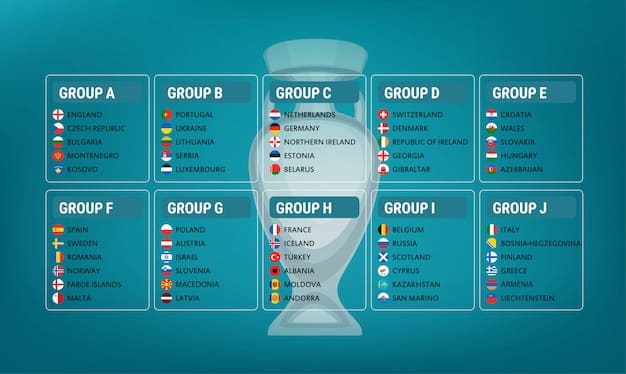World Cup 2026: How the New Format Impacts US Game Count

The 2026 World Cup, hosted in part by the US, introduces a new format. This change significantly impacts the number of games played in the US, increasing opportunities for fans to witness world-class soccer on American soil.
The 2026 FIFA World Cup is set to be a historic event, not only for being the first to be co-hosted by three nations—the United States, Canada, and Mexico—but also for its expanded format. This raises an important question: World Cup: How Will the New Format Impact the Number of Games Played in the US in 2026?
Understanding these changes and their implications is crucial for soccer fans and the sports industry in the US. Let’s delve into the details.
Understanding the 2026 World Cup Format
The 2026 World Cup marks a significant shift from previous tournaments. The expansion from 32 to 48 teams is the most notable change.
This change will impact every aspect of the tournament, including the number of games played and the distribution of matches across host nations. This section will detail these crucial adjustments.
Key Changes in the Format
The new format introduces several changes designed to enhance the competition and provide more opportunities for teams to participate.
- Expanded Teams: The tournament will now feature 48 teams, up from the traditional 32.
- Group Stage: Teams will be divided into 12 groups of four teams each.
- Knockout Stage: The top two teams from each group, along with the eight best third-placed teams, will advance to the round of 32.
These changes drastically alter the structure and dynamics of the tournament, impacting everything from the number of games played to the strategies employed by participating nations.
In summary, the expanded format of the 2026 World Cup promises a more inclusive and competitive tournament, with significant implications for the host nations.

How Many Games Will Be Played in Total?
One of the most immediate impacts of the new format is the increased number of games. Understanding the total number of matches is essential to grasping the scope of the 2026 World Cup.
It is important to know exactly how many games will be played to fully appreciate the scale of the tournament. Let’s break down the numbers.
Total Number of Matches
With the expansion to 48 teams, the total number of matches will increase significantly.
The tournament will now feature a total of 104 matches, a substantial increase from the 64 matches played in previous 32-team World Cups.
The increase in matches provides more opportunities for fans to engage with the tournament. It also gives more exposure for the host nations.
In conclusion, the increase to 104 matches in the 2026 World Cup is a direct result of the expanded format, promising more soccer action and excitement for fans worldwide.
Estimating the Number of Games in the US
Given that the US is one of the three host nations, estimating the number of games it will host is crucial. While the exact distribution is subject to final confirmation by FIFA, projections can be made based on various factors.
Predicting this number involves considering historical precedents, infrastructure capabilities, and FIFA’s strategic goals for the tournament. Let’s explore the possibilities.
Factors Influencing Game Allocation
Several factors influence how FIFA allocates games among the host nations.
- Stadium Capacity: Larger stadiums are more likely to host higher-profile matches.
- Infrastructure: Cities with better transportation, accommodation, and training facilities often receive more games.
- Geographic Location: FIFA will try to distribute matches equitably across different regions to cater to diverse fan bases.
These factors play a vital role in determining which cities and nations will host the most games. So it’s about more than just a toss up.
In summary, factors such as stadium capacity, infrastructure, and geographic location will influence the distribution of games across the host nations, with the US likely to host a significant portion of the matches.

Potential Impact on the US Economy
Hosting a significant number of World Cup games can have a substantial impact on the US economy. From tourism to infrastructure development, there are numerous economic benefits to consider.
Understanding these potential benefits is vital for stakeholders, including local governments, businesses, and the sports industry. Let’s examine the potential economic impacts.
Economic Benefits of Hosting
Hosting World Cup games can bring a range of economic benefits to the United States.
- Tourism Revenue: An influx of international visitors will generate significant revenue for hotels, restaurants, and local businesses.
- Job Creation: Hosting the tournament will create numerous jobs in hospitality, transportation, and event management.
- Infrastructure Investment: Hosting duties will spur investment in upgrading stadiums and public transportation systems.
These benefits highlight the potential for a positive economic impact from hosting World Cup games. As such, this topic is relevant to World Cup: How Will the New Format Impact the Number of Games Played in the US in 2026?
To sum up, hosting a significant number of World Cup games offers the US potential benefits by bringing tourism revenue, creating jobs, and stimulating investment in infrastructure.
Comparing to Previous World Cups Hosted by the US
Looking back at previous World Cups hosted by the US can offer insights into what to expect in 2026. Comparing the scale, economic impact, and fan engagement can help us understand the potential magnitude of the upcoming tournament.
Analyzing these past experiences provides valuable context for understanding the opportunities and challenges that lie ahead. Let’s draw some parallels.
Lessons from USA 1994
The 1994 World Cup, hosted entirely in the United States, was a transformative event for soccer in the country.
Increased interest and participation in the sport emerged after the USA ’94 tournament. It showcased the potential of soccer in a nation traditionally dominated by other sports.
The event helped to build the foundation for the growth of professional soccer leagues like Major League Soccer (MLS).
In conclusion, the lessons from USA 1994 highlight the potential for the 2026 World Cup to further elevate the sport’s popularity and development in the country.
| Key Point | Brief Description |
|---|---|
| ⚽ Expanded Format | 48 teams, 104 total matches in the 2026 World Cup. |
| 🏟️ US Game Count | US will likely host a significant portion of the 104 matches. |
| 📈 Economic Impact | Tourism revenue, job creation, and infrastructure investments. |
| 🏆 Lessons from 1994 | USA ’94 boosted soccer’s popularity and built foundations for MLS. |
Frequently Asked Questions
The new format increases the total number of games to 104, which means the US will likely host more games than it would have under the previous 32-team format. The exact number of games is yet to be confirmed by FIFA.
The main change is expansion to 48 teams. These teams will be split into 12 groups of four. The top two teams from each group and the eight best third-placed teams advance to the next round.
FIFA considers stadium capacity, infrastructure quality, and geographic location, and fan base when allocating games. Cities with larger stadiums and better facilities are more likely to host more games.
Hosting World Cup games can generate significant tourism revenue, create jobs in hospitality and event management, and spur infrastructure investment throughout the country.
Unlike 1994 when it was the sole host, the US is co-hosting in 2026. The new format and higher number of teams are expected to bring even greater economic, social, and infrastructural benefits. World Cup: How Will the New Format Impact the Number of Games Played in the US in 2026?
Conclusion
The 2026 FIFA World Cup presents an exciting opportunity for the United States. The new format and increased number of games will have a significant impact on the number of matches played in the US, as well as boosting revenue.
By understanding these changes and their implications, fans, businesses, and local governments can prepare for what promises to be a historic and transformative event for soccer in the nation.





